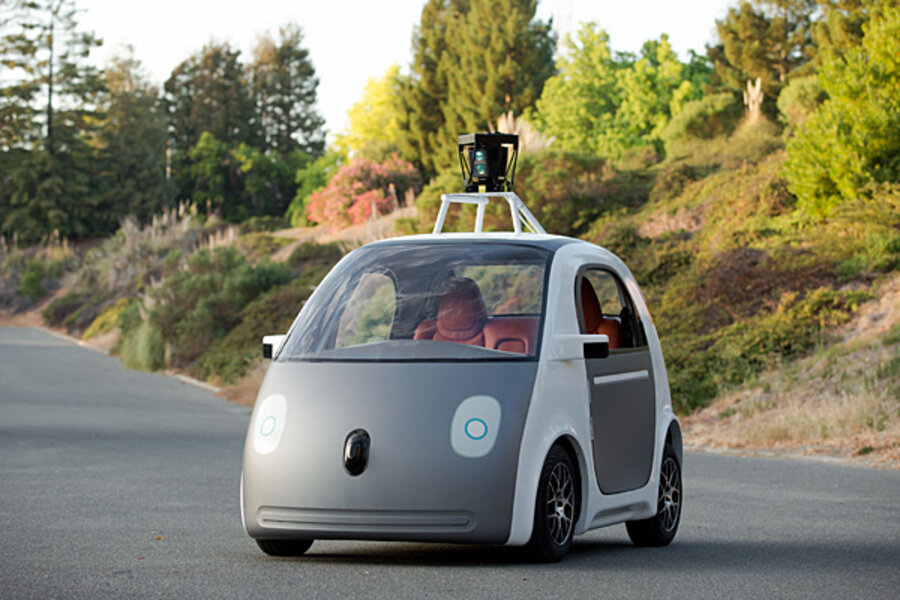Google self-driving car: no steering wheel, no problem?
Loading...
This is probably not the car you'll be whisked around cities in, in the future.
Which is either a good or bad thing, depending on how much you like cars that look like koala bears on a substance recently legalized in Colorado.
But it is Google's latest, dedicated test vehicle for its autonomous car technology – an electric, steering-wheel and brake-less pod set to embark upon pilot projects in Google's home state of California.
Previously, Google's autonomous testing vehicles have been adaptions of commonly-available cars – the Toyota Prius, for example, or the Lexus RX 450h.
But, reports The New York Times, Google's engineers have had trouble with one major factor in the autonomous car equation: the human.
Making a driverless car hasn't been that difficult. In hundreds of thousands of miles of testing, the cars haven't yet crashed into anything under their own instruction.
But designing a driverless car in which the human passenger may need to take over at any point hasn't been so easy.
A human driver may be reading, or daydreaming, or even sleeping. They may not be any better at dealing with a given situation than the car itself is--so the easiest thing to do is simply remove them from the equation.
"We saw stuff that made us a little nervous," said Christopher Urmson, one of Google's car project directors, of the company's autonomous and self-driven testing.
Google employees had been using the vehicles for their commutes to work, but the data Google got back led Google to work on vehicles that wouldn't need a human driver in any situation.
To us, that has a fairly clear, slightly Orwellian and very science-fiction message: The autonomous car was much easier to trust than the fallible, distracted bags of meat behind the wheel.
Google isn't taking any chances with its test car though, even though the little electric bubble is only designed for 25 mph speeds and campus-type driving tasks.
The front of the car is made from foam, just in case it doesn't spot a pedestrian when scanning 600 feet in all directions. That could make it the comfiest car ever to be run over by – though the likelihood of it making such a mistake is low.
It does have rear-view mirrors too, a hangup of Californian laws – though they're of limited use to the passengers inside.
Californian laws also require a degree of human control right now, so Google's first prototypes will have all the normal fixtures. But Google hopes to persuade regulators its cars can operate without that human safety net – so watch this space.
There are, as Wired points out, things autonomous cars cannot do right now.
They're still not great in bad weather, the effects of which plays havoc with the car's sensors. It also can't go "off the grid" -– lose reception with various external systems. Urmson says the car will "do something safe" if this situation is encountered on the road.
It also can't understand fringe scenarios like a traffic cop redirecting the flow of traffic--hand signals mean nothing to it. This is a problem that still needs addressing – though apparently, the car can detect a cyclist's hand-movements, if they signal an intention to turn.
And if a little fluffy squirrel bounds carelessly into the road, it may not stay fluffy for long--small creatures like that are currently too small for Google's sensors to pick up. Larger creatures--humans, deer, buffalo--are much easier to spot.
What Google's car can do is recognize potholes, drive with the flow of traffic--even if that involves higher-than-legal speeds--and edge forward at stop signs to signal its intentions to move, rather than sitting there meekly letting humans take advantage at four-way stops.
It's all very impressive though, and while we won't be driving around in little electric pods for some time (if they let us drive at all), Google does see applications in other situations – autonomous taxis, for example.
You could simply call the car with a smartphone application and have it arrive at your door, its route to your destination already worked out.
It's likely this could cut waiting times--the cars would be "on-demand"--and researchers at the Earth Institute at Columbia University suggest it could cut the running costs of a taxi trip in Manhattan from $4 per trip mile to just 50 cents.
Impressive. Though we think it may be easier to get California to OK fully-autonomous vehicles than it will be to replace Manhattan's 13,000 taxis--and their drivers – with driverless cars...





